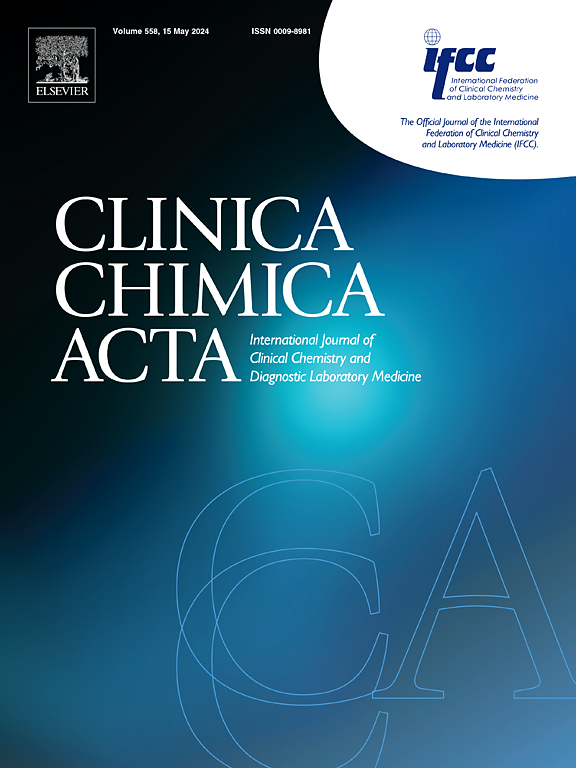IL-25在诱导痰中的表达可作为支气管哮喘儿童的可靠生物标志物
IF 2.9
3区 医学
Q2 MEDICAL LABORATORY TECHNOLOGY
引用次数: 0
摘要
背景:哮喘是一种以可逆性气道阻塞和持续性气道炎症为特征的慢性呼吸道疾病,在儿童中表现为高度异质性的疾病。进一步了解其复杂性对于确定适用的生物标志物和靶向治疗至关重要。白细胞介素-25 (IL-25)已被证明在哮喘的发病机制中起关键作用。方法为了研究IL和25的表达与临床特征的关系,我们招募了46名6-17岁的哮喘儿童和15名年龄匹配的健康对照。将哮喘患者分为A组(未治疗组,n = 24)和B组(治疗对照组,n = 22)。采用ELISA法和PCR法分别测定血清中IL-25蛋白水平和诱导痰中IL-25 mRNA水平。结果年龄(P = 0.32)、性别(P = 0.67)、BMI (P = 0.144)组间差异无统计学意义。两组患者痰液中IL-25 mRNA均较对照组显著升高(P <;A组0.001,P <;B组0.05)。A组患者痰中IL-25蛋白水平高于对照组(P <;0.001)和B组(P <;0.05)。A组(未使用抗哮喘药物组)痰液中IL-25 mRNA表达量显著高于B组(使用抗哮喘药物治疗哮喘对照组)(P <;诱导痰和血均为0.05)。此外,IL-25 mRNA表达与CRP (P = 0.007)、FeNO (P = 0.04)、FEV1/FVC (%) (P = 0.01)、诱导痰嗜酸性粒细胞计数(%)(P = 0.03)、疾病严重程度(P = 0.042)、抗哮喘治疗(P <;0.05)。值得注意的是,抗哮喘治疗后,诱导痰中的IL-25水平在分子和基因水平上均显著下降,这表明其有可能作为评估治疗效果和哮喘控制的生物标志物。结论il -25在诱导痰中的表达可能是支气管哮喘儿童的可靠生物标志物,但需要进一步的大规模研究来证实这些发现。本文章由计算机程序翻译,如有差异,请以英文原文为准。
IL-25 expression in induced sputum may serve as a reliable biomarker in children with bronchial asthma
Background
Asthma is a chronic respiratory disease characterized by reversible airway obstruction and persistent airway inflammation, presenting as a highly heterogeneous disorder in children. Further understanding of its complexity is essential to identify applicable biomarkers and targeted therapies. Interleukin-25 (IL-25) has been shown to play a critical role in the pathogenesis of asthma.
Methods
To investigate the association between IL and 25 expression and clinical characteristics, we enrolled 46 children with asthma (age 6–17 years) and 15 age-matched healthy controls. Asthma patients were stratified into Group A (untreated, n = 24) and Group B (treatment-controlled, n = 22). IL-25 protein levels in serum and IL-25 mRNA in induced sputum were quantified using ELISA and PCR, respectively.
Results
No significant intergroup differences existed in age (P = 0.32), sex (P = 0.67), or BMI (P = 0.144). IL-25 mRNA in sputum was significantly elevated in both groups versus controls (P < 0.001 in Group A and P < 0.05 in Group B). Sputum IL-25 protein levels were higher in Group A versus controls (P < 0.001) and Group B (P < 0.05). IL-25 mRNA expression in sputum was significantly higher in Group A (without anti-asthma drugs) compared to Group B (with controlled asthma treated with anti-asthma drugs) (P < 0.05 in both induced sputum and blood). Furthermore, IL-25 mRNA expression correlated with CRP (P = 0.007), FeNO (P = 0.04), FEV1/FVC (%) (P = 0.01), induced sputum eosinophil count (%) (P = 0.03), disease severity (P = 0.042), and anti-asthma treatment (P < 0.05). Notably, IL-25 levels in induced sputum decreased significantly at both molecular and gene levels following anti-asthma treatment, suggesting its potential as a biomarker for evaluating treatment efficacy and asthma control.
Conclusion
IL-25 expression in induced sputum may serve as a reliable biomarker in children with bronchial asthma, though further large-scale studies are needed to confirm these findings.
求助全文
通过发布文献求助,成功后即可免费获取论文全文。
去求助
来源期刊

Clinica Chimica Acta
医学-医学实验技术
CiteScore
10.10
自引率
2.00%
发文量
1268
审稿时长
23 days
期刊介绍:
The Official Journal of the International Federation of Clinical Chemistry and Laboratory Medicine (IFCC)
Clinica Chimica Acta is a high-quality journal which publishes original Research Communications in the field of clinical chemistry and laboratory medicine, defined as the diagnostic application of chemistry, biochemistry, immunochemistry, biochemical aspects of hematology, toxicology, and molecular biology to the study of human disease in body fluids and cells.
The objective of the journal is to publish novel information leading to a better understanding of biological mechanisms of human diseases, their prevention, diagnosis, and patient management. Reports of an applied clinical character are also welcome. Papers concerned with normal metabolic processes or with constituents of normal cells or body fluids, such as reports of experimental or clinical studies in animals, are only considered when they are clearly and directly relevant to human disease. Evaluation of commercial products have a low priority for publication, unless they are novel or represent a technological breakthrough. Studies dealing with effects of drugs and natural products and studies dealing with the redox status in various diseases are not within the journal''s scope. Development and evaluation of novel analytical methodologies where applicable to diagnostic clinical chemistry and laboratory medicine, including point-of-care testing, and topics on laboratory management and informatics will also be considered. Studies focused on emerging diagnostic technologies and (big) data analysis procedures including digitalization, mobile Health, and artificial Intelligence applied to Laboratory Medicine are also of interest.
 求助内容:
求助内容: 应助结果提醒方式:
应助结果提醒方式:


